Philips Compact Cassette Recorder EL-3302
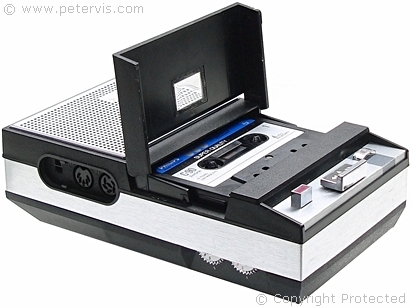

The EL-3302 (EL3302) was a mono compact cassette recorder made by the Philips Company in 1967. Manufactured to a mass volume and produced in many countries, the majority of the earlier units came from Austria. This was a player and recorder, with built in erase bias for a separate erase head providing high quality audio reproduction from compact cassettes. It has a full range of tape control features including fast-forward, rewind, and play. The pause function was a switch on the microphone, which simply cut the power to the motor.
The DIN sockets provide audio input / output facility, external microphone connection, and mains adapter facility. The internal speaker was very small and the manufactures thoughtfully provided a 2-pin socket to connect a better external 8 Ω speaker.
The unit is only 20 cm × 11.5 cm × 5.5 cm in size and packed with electronic and mechanical engineering. Removing the plastic shell reveals a metal die-cast chassis. The tape transport mechanism, and control linkages are metal and reliable. All the pulleys, and drive wheels, including the capstan flywheel are metal.
The internal circuitry, built on a copper clad printed circuit board, has a rich assortment of components. The component density is high, which is why the resistors are in an upright position. The circuit uses ten metal-tube germanium transistors, which are AC12x series. There are two transistors in a "Class A" arrangement form the audio power output circuit, whilst five transistors form the record / playback circuitry.
The unit also houses a small separate PCB consisting of a two-transistor circuit, which forms the voltage and speed regulator circuit of the capstan motor. The earlier models of this tape recorder did not have the speed regulator, and this appears as a later addition. Five "C" size dry cells, or an external 7.5 V adapter powers the unit, and if you cannot find the adapter then, I have an article showing how to make a Philips EL-3302 Adapter. In this multi-page article, you can see every aspect of this cassette recorder, by using the links below.
Boys Toys
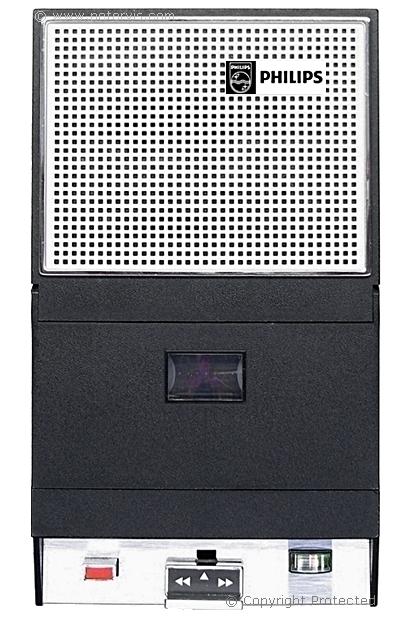
The first model of the series, EL3300, was an exhibit at the Berlin Radio Fair in August 1963, together with the first Compact Cassette. The label inside my machine indicates the year of production as 1967. However, production on this model began as early as 1965!
The EL3302 was an improvement over the earlier EL3300, and EL 3301 models. At one time, I had those as well. In America, "Norelco Carry Corder EL 3301" became the famous name. There was also the Philips N2202 and N2203 that looked slightly different from the outside but had identical electronics, and transport mechanism. I remember opening those as well to change their drive belts.
This cassette recorder was one of the smallest cassette recorders of its time employing transistor technology. In our time, this was the equivalent of a modern-day PSP. However, this was far more fun. All the famous pop singers carried one around with them on the shoulder strap.
The Record Button
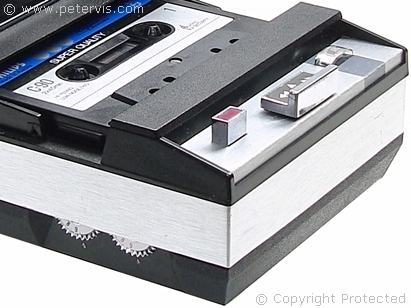
To record on a cassette, push down the red button, and simultaneously slide down the play button. The red button had a linkage, which connected to a long switch on the main audio printed circuit board. Its purpose is to reconfigure the circuitry between playback and record modes, and this made the circuit design more economical and compact.
Moving Coil Meter

This unit has a moving coil meter, which operates as a recording level indicator, and battery level meter. A small rotary volume at the side of the unit controls the recording level.
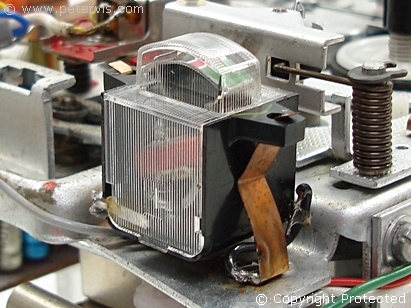
Here is an internal view of the meter, which at the time was revolutionary. As you can see, it mounts vertically to save space.
What I love about Philips is their products are very thoughtfully designed. They have been the leaders in innovative technology right from the start, and they continue to innovate with their latest designs. I just recently saw their "GoGear" range of Wi-Fi products, and their Cinema 21:9 Platinum 3D 58" television range, and it is all impressive! With the recent recession, you can get all of these gadgets online for a bargain basement affordable price as well
Rotary Volume Controls
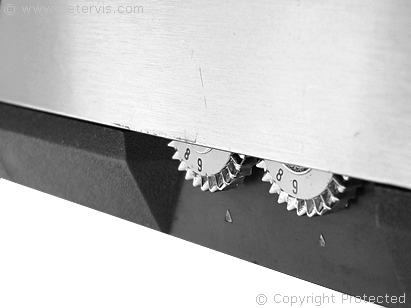
This photograph shows the rotary volume control and the input level control for recording purposes. There is great attention to design and engineering.
5 Pin DIN Audio Connections

Here is a drawing of the 5-pin DIN socket, which is BU13 on the circuit diagram and service manual. Pin 1 and pin 4 provide a line-in facility, which enables one to record on this cassette recorder using an external audio source. Pin 5 and pin 3 provide an audio output signal, which can feed almost any audio equipment with a similar DIN socket.
This input / output port is compatible with that on the Sony tape recorder, as shown in the Sony TC-152SD Audio Connections article. Even though the Sony tape recorder is stereo, one can achieve very quality good mono sound reproduction.
When recording between DIN sockets, a cable with crossover connections is required. This means that the input pins on one end connect to the output pins on the other end. Almost everyone of that era will probably remember making their own DIN cable, and soldering the pins. It was all good fun.
The ground pin 2 is common to both the line input and line output pins. Interestingly, the input and output join internally through a 1.5 MΩ resistor to provide a stability feedback loop.
Cost / eBay
The EL-3302 was extremely popular and mass-produced for sale all over the world. You will see one in second-hand shops, flea markets, and charity shops. You might already have one in your attic!
It is a lovely bit of engineering that is gathering interest from audio professionals, and the best place to sell it is on eBay. If you have one in good condition together with the box and accessories, then it could fetch a packet.
Specifications
| Model | Philips Compact Cassette Recorder EL-3302A/15D |
| Date of Manufacture | Oct 1967 |
| Serial No | 110647 |
| Tape Speed | 4.75 cm/sec |
| Recording System | Mono |
| Frequency Response | 80 Hz to 10 kHz ±6 dB |
| Speaker | 8 Ω |
| Transistors | 2 × AC128, 3 × BA114, 4 × AC125, 2 × AC126, 2 × AC127 |
| Mass | 1.2 kg including batteries |
| Size | 20 cm × 11.5 cm × 5.5 cm |
| Schematic | EL-3302 Circuit Diagram |
Accessories
| Accessories | Part Number |
| Microphone | EL3797/50 |
| Adapter | EL1998 D/00A |
| Loudspeaker Box | 22GL559 |
| Cassettes | EL1903/00, EL1903/51 |
This Article Continues...

Philips Compact Cassette Recorder EL-3302
Philips EL-3302 / Philips EL-3302A
Philips EL-3302 Tape Transport
Philips EL-3302 Head Design
Philips EL-3302 PCB
Philips EL-3302 Plastic Case
Philips EL-3302 Power Supply
Philips EL-3302 Videos
Philips EL-3302 Aesthetics
Philips EL-3302 Adapter
